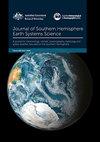Seasonal climate summary for the southern hemisphere (winter 2018): fifteenth-warmest and fourteenth-driest
IF 3.6
4区 地球科学
Q1 Earth and Planetary Sciences
引用次数: 0
Abstract
This is a summary of the southern hemisphere atmospheric circulation patterns and meteorological indices for winter 2018; an account of seasonal rainfall and temperature for the Australian region and the broader southern hemisphere is also provided. The climate influences from the El Niño–Southern Oscillation and the Indian Ocean Dipole were weak, with both demonstrating neutral conditions over the season. It was a dry and warm winter for Australia, being the fourteenth-driest and fifteenth-warmest (in terms of mean temperature) in a record of 119 and 109 years respectively. The warm and dry conditions were particularly pronounced over eastern Australia during July. Maximum temperatures were above average while minimum temperatures were below average.南半球季节气候摘要(2018年冬季):最暖第十五位,最干第十四位
这是2018年冬季南半球大气环流模式和气象指数的总结;还提供了澳大利亚地区和更广泛的南半球的季节性降雨和温度的说明。El Niño-Southern涛动和印度洋偶极子对气候的影响较弱,在整个季节都表现为中性状态。对澳大利亚来说,这是一个干燥而温暖的冬天,分别是119年和109年记录中第14个最干燥和第15个最温暖的冬天(就平均温度而言)。7月,澳大利亚东部的温暖和干燥情况尤为明显。最高气温高于平均气温,而最低气温低于平均气温。
本文章由计算机程序翻译,如有差异,请以英文原文为准。
求助全文
约1分钟内获得全文
求助全文
来源期刊

Journal of Southern Hemisphere Earth Systems Science
Earth and Planetary Sciences-Oceanography
CiteScore
8.10
自引率
8.30%
发文量
0
审稿时长
>12 weeks
期刊介绍:
The Journal of Southern Hemisphere Earth Systems Science (JSHESS) publishes broad areas of research with a distinct emphasis on the Southern Hemisphere. The scope of the Journal encompasses the study of the mean state, variability and change of the atmosphere, oceans, and land surface, including the cryosphere, from hemispheric to regional scales.
general circulation of the atmosphere and oceans,
climate change and variability ,
climate impacts,
climate modelling ,
past change in the climate system including palaeoclimate variability,
atmospheric dynamics,
synoptic meteorology,
mesoscale meteorology and severe weather,
tropical meteorology,
observation systems,
remote sensing of atmospheric, oceanic and land surface processes,
weather, climate and ocean prediction,
atmospheric and oceanic composition and chemistry,
physical oceanography,
air‐sea interactions,
coastal zone processes,
hydrology,
cryosphere‐atmosphere interactions,
land surface‐atmosphere interactions,
space weather, including impacts and mitigation on technology,
ionospheric, magnetospheric, auroral and space physics,
data assimilation applied to the above subject areas .
Authors are encouraged to contact the Editor for specific advice on whether the subject matter of a proposed submission is appropriate for the Journal of Southern Hemisphere Earth Systems Science.
 求助内容:
求助内容: 应助结果提醒方式:
应助结果提醒方式:


